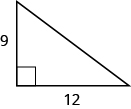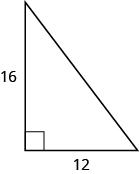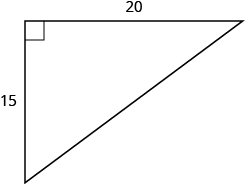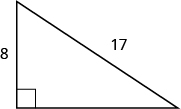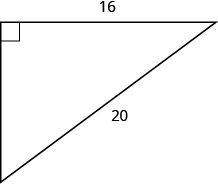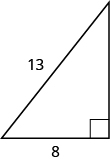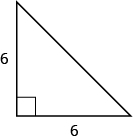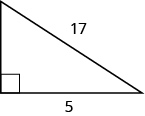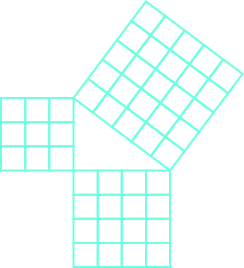Exercises: Use Properties of Angles, Triangles, and the Pythagorean Theorem (6.1)
Exercises: Use the Properties of Angles
Instructions: For questions 1-2, find:
a. the supplement and
b. the complement of the given angle
1. [latex]53^\circ[/latex]
Solution
a. [latex]127^\circ[/latex]
b. [latex]37^\circ[/latex]
Solution
a. [latex]151^\circ[/latex]
b. [latex]61^\circ[/latex]
Exercises: Use the Properties of Angles
Instructions: For questions 3-10, use the properties of angles to solve.
3. Find the supplement of a [latex]135^\circ[/latex] angle.
Solution
[latex]45^\circ[/latex]
4. Find the complement of a [latex]38^\circ[/latex] angle.
Solution
[latex]52^\circ[/latex]
5. Find the complement of a [latex]27.5^\circ[/latex] angle.
Solution
[latex]62.5^\circ[/latex]
6. Find the supplement of a [latex]109.5^\circ[/latex] angle.
Solution
[latex]70.5^\circ[/latex]
Solution
[latex]62^\circ,\;118^\circ[/latex]
9. Two angles are complementary. The smaller angle is [latex]34^\circ[/latex] less than the larger angle. Find the measures of both angles.
Solution
[latex]62^\circ,\;28^\circ[/latex]
Exercises: Use the Properties of Triangles
11. The measures of two angles of a triangle are [latex]26^\circ[/latex] and [latex]98^\circ[/latex]. Find the measure of the third angle.
Solution
[latex]56^\circ[/latex]
12. The measures of two angles of a triangle are [latex]61^\circ[/latex] and [latex]84^\circ[/latex]. Find the measure of the third angle.
Solution
[latex]35^\circ[/latex]
13. The measures of two angles of a triangle are [latex]105^\circ[/latex] and [latex]31^\circ[/latex]. Find the measure of the third angle.
Solution
[latex]44^\circ[/latex]
14. The measures of two angles of a triangle are [latex]47^\circ[/latex] and [latex]72^\circ[/latex]. Find the measure of the third angle.
Solution
[latex]61^\circ[/latex]
15. One angle of a right triangle measures [latex]33^\circ[/latex]. What is the measure of the other angle?
Solution
[latex]57^\circ[/latex]
16. One angle of a right triangle measures [latex]51^\circ[/latex]. What is the measure of the other angle?
Solution
[latex]39^\circ[/latex]
17. One angle of a right triangle measures [latex]22.5^\circ[/latex]. What is the measure of the other angle?
Solution
[latex]67.5^\circ[/latex]
18. One angle of a right triangle measures [latex]36.5^\circ[/latex]. What is the measure of the other angle?
Solution
[latex]53.5^\circ[/latex]
19. The two smaller angles of a right triangle have equal measures. Find the measures of all three angles.
Solution
[latex]45^\circ,\;45^\circ,\;90^\circ[/latex]
21. The angles in a triangle are such that the measure of one angle is twice the measure of the smallest angle, while the measure of the third angle is three times the measure of the smallest angle. Find the measures of all three angles.
Solution
[latex]30^\circ,\;60^\circ,\;90^\circ[/latex]
Exercises: Find the Length of the Missing or Indicated Side
Instructions: For questions 23-24, find the length of the indicated side(s).
23. In the following exercises, [latex]\bigtriangleup ABC[/latex] is similar to [latex]\bigtriangleup XYZ[/latex]. Find the length of the indicated side.

Solution
Side [latex]b[/latex] = [latex]12[/latex]
Side [latex]x[/latex] = [latex]6[/latex]
a. Find the distance from Los Angeles to San Francisco.
b. Find the distance from San Francisco to Las Vegas.
Solution
a. [latex]351[/latex] miles
b. [latex]567[/latex] miles
Exercises: Use the Pythagorean Theorem
Instructions: For questions 25-28, use the Pythagorean Theorem to find the length of the hypotenuse.
25.
Solution
[latex]20[/latex]
Solution
[latex]25[/latex]
Exercises: Find the Length of the Missing Side
Exercises: Pythagorean Theorem Applications
Instructions: For questions 37-40, solve. Approximate to the nearest tenth, if necessary.
37. A [latex]13 foot[/latex] string of lights will be attached to the top of a [latex]12 foot[/latex] pole for a holiday display. How far from the base of the pole should the end of the string of lights be anchored?

Solution
[latex]5[/latex] feet
38. Pam wants to put a banner across her garage door to congratulate her son on his college graduation. The garage door is [latex]12[/latex] feet high and [latex]16[/latex] feet wide. How long should the banner be to fit the garage door?

Solution
[latex]20[/latex] feet
39. Chi is planning to put a path of paving stones through her flower garden. The flower garden is a square with sides of [latex]10[/latex] feet. What will the length of the path be?
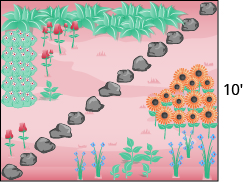
Solution
[latex]14.1[/latex] feet
40. Brian borrowed a [latex]20 foot[/latex] extension ladder to paint his house. If he sets the base of the ladder [latex]6[/latex] feet from the house, how far up will the top of the ladder reach?
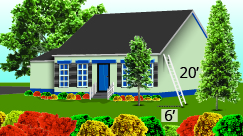
Solution
[latex]19.1[/latex] feet
Exercises: Everyday Math
Instructions: For questions 41-42, answer the given everyday math word problems.
Solution
[latex]2.9 feet[/latex]
42. Measurement A city engineer plans to build a footbridge across a lake from point [latex]X[/latex] to point [latex]Y[/latex], as shown in the picture below. To find the length of the footbridge, she draws a right triangle [latex]\bigtriangleup XYZ[/latex] with right angle at [latex]X[/latex]. She measures the distance from [latex]X[/latex] to [latex]Z[/latex] is [latex]800[/latex] feet, and from [latex]Y[/latex] to [latex]Z[/latex] is [latex]1,000[/latex] feet. How long will the bridge be?
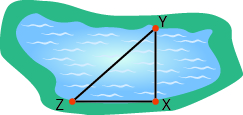
Exercises: Writing Exercises
Instructions: For questions 43-44, answer the given writing exercises.
Solution
Answers will vary.


